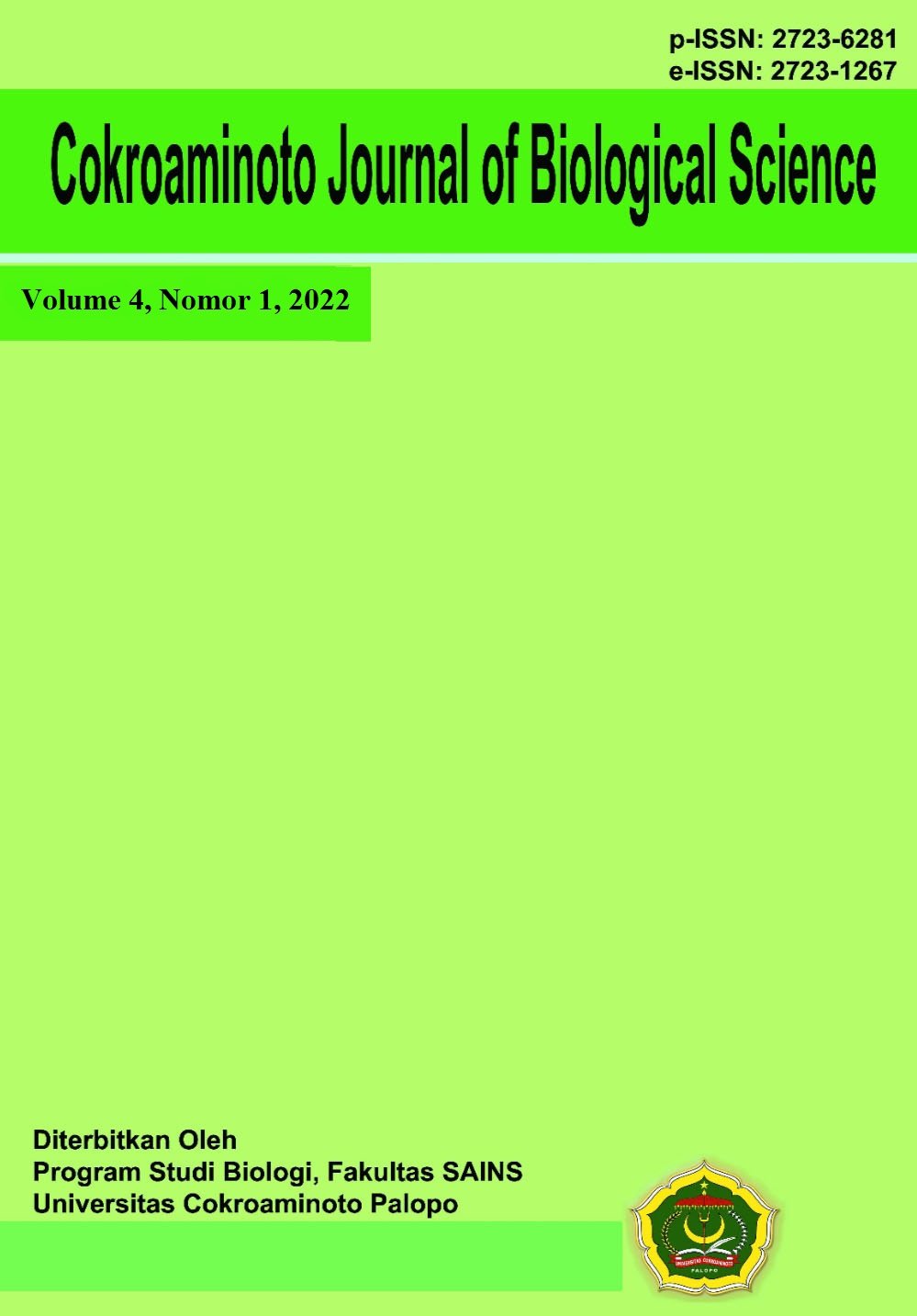Pengaruh Pupuk Organik Cair (POC) Limbah Kulit Pisang Raja (Musa paradisiaca L.) Terhadap Pertumbuhan Awal Tanaman Kangkung Darat (Ipomea reptans Poir)
Keywords:
Pupuk Organik Cair, Kangkung Darat, Kulit Pisang Raja, PertumbuhanAbstract
Penelitian ini bertujuan untuk mengetahui pengaruh pupuk organik cair (POC) dari limbah kulit buah pisang raja terhadap pertumbuhan awal tanaman kangkung darat (Ipomea reptans Poir), dan konsentrasi POC yang memberikan hasil terbaik terhadap pertumbuhan awal tanaman kangkung darat. Penelitian ini menggunakan rancangan acak lengkap (RAL) dengan 5 perlakuan yaitu P0 (kontrol/tanpa pemberian POC), P1= 15 ml POC, P2= 30 ml POC, P3= 45 ml POC, dan P4= 60 ml POC. Setiap perlakuan terdiri atas 5 ulangan. Penelitian dilakukan selama 28 hari. Hasil penelitian ini menunjukkan bahwa perlakuan dengan berbagai konsentrasi atau dosis pupuk organik cair memberikan pengaruh nyata terhadap tinggi tanaman dan panjang daun, tetapi berpengaruh tidak beda nyata terhadap warna daun, berat basah, dan jumlah daun tanaman kangkung darat. Perlakuan terbaik diperoleh pada perlakuaan P2 (30 ml POC) dengan rata-rata tinggi tanaman 36,22 cm, panjang daun 7,12 cm, warna daun 3,6, jumlah daun 8,8 helai dan berat basah 3,15 g.
Downloads
References
[2] D. P. Aditya. “Budidaya kangkung. Jakarta”. Agromedia Pustaka. (2009).
[3] Haryoto. “Bertanam Kangkung Raksasa di Pekarangan. Yogyakarta: Kanisius. (2009)
[4] D. Harjana. “Kandungan Gizi dan Manfaat Kangkung”. Jakarta. Agromedia Pustaka. (2016).
[5] Evita. Pengaruh Berbagai Konsentrasi Pupuk Organik Cair terhadap Pertumbuhan dan Hasil Tanaman Kacang Buncis ( Phaseolus vulgaris L). Jurnal Agronomi, Vol. 13. No. 1, 21-24. (2009).
[6] F.P. Gardner, R. B. Pearce and R. L. Mitchel. “Fisiologi Tanaman Budidaya”. Terjemahan Herawati Susilo. UI Press. Jakarta (1991)
[7] S. Puspadewi, W. Sutari, dan Kusumiyati. “Pengaruh Konsentrasi Pupuk Organik Cair (POC) dan Dosis Pupuk N, P, K terhadap Pertumbuhan dan Hasil Tanaman Jagung Manis (Zea mays L. Var Rugosa Bonaf). Kultivar Talenta”. Jurnal Kultivasi, Vol. 15, No. 3, 208-216 (2016).
[8] E. A. Diatri, L. Marlina dan R. Zuhri. “Pengaruh Pemberian Pupuk Organik Cair Dari Limbah Kulit Buah Pisang Lilin (Musa paradisiaca L.) Terhadap Pertumbuhan Tanaman Bayam Merah (Amaranthus tricolor L. var. blitum rubrum)”. Biocolony: Jurnal Pendidikan Biologi dan Biosains, Vol. 1, No.2, 16-24 (2018).
[9] F. B. Salisbury and C.W. Ross. “Fisiologi Tumbuhan Jilid 1”. Bandung: ITB Press. (1995)
[10] B. Latarang dan A. Syakur. “Pertumbuhan dan Hasil Bawang Merah (Allium ascalonicus L.) pada Berbagai Dosis Pupuk Kandang”. Agroland: Jurnal Ilmu Pertanian, Vol. 13, No. 3, 265-269. (2006)
[11] M. Sutedjo. “Pupuk dan Cara Pemupukan”. Bina Aksara. Jakarta. (2002)
[12] Marsono dan Sigit. “Petunjuk Penggunaan Pupuk”. Penebar Swadaya. Jakarta. (2001).
Downloads
Published
How to Cite
Issue
Section
License
In submitting the manuscript to the journal, the authors certify that:
- They are authorized by their co-authors to enter into these arrangements.
- The work described has not been formally published before, except in the form of an abstract or as part of a published lecture, review, thesis, or overlay journal.
- That it is not under consideration for publication elsewhere,
- That its publication has been approved by all the author(s) and by the responsible authorities – tacitly or explicitly – of the institutes where the work has been carried out.
- They secure the right to reproduce any material that has already been published or copyrighted elsewhere.
- They agree to the following license and copyright agreement.
License and Copyright Agreement
Authors who publish with this journal agree to the following terms:
- Authors retain copyright and grant the journal right of first publication with the work simultaneously licensed under Creative Commons Attribution License (CC BY 4.0) that allows others to share the work with an acknowledgment of the work's authorship and initial publication in this journal.
- Authors are able to enter into separate, additional contractual arrangements for the non-exclusive distribution of the journal's published version of the work (e.g., post it to an institutional repository or publish it in a book), with an acknowledgment of its initial publication in this journal.
- Authors are permitted and encouraged to post their work online (e.g., in institutional repositories or on their website) prior to and during the submission process, as it can lead to productive exchanges, as well as earlier and greater citation of published work.

